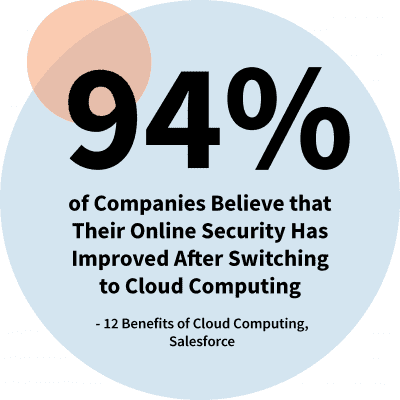Compelling Cost Savings, Increased Security, Flexibility, and Reliability Are Tipping the Scales Toward Cloud Migration.
In today’s data-driven business environment, there’s a growing sentiment that every enterprise, no matter what it does, is a data and analytics company. As generalizations go, this one is becoming increasingly accurate, with more and more companies relying on revenue technologies like CRM to understand (and improve) how internal stakeholders engage with customers, gathering gigabytes of communications and revenue data daily.
Once it’s created or gathered, that data (some of which may pose security and regulatory concerns) has to live somewhere. That somewhere, of course, is servers. And for businesses in regulated industries, the risk/reward profile of maintaining data centers on-premise is rapidly changing.
“Technology and service providers that fail to adapt to the pace of cloud shift face increasing risk of becoming obsolete or, at best, being relegated to low-growth markets.” – Michael Merrilow, Gartner Says More Than Half of Enterprise IT Spending in Key Market Segments Will Shift to the Cloud by 2025, Gartner, February 9, 2022
Going All Out for Cloud Data Infrastructure
At the start, apprehensions about cloud migration were understandable. IT and data security teams expressed concerns about cloud security, server uptime, system integration, data management, and hardware and software maintenance. But in recent years, the cloud has rapidly emerged as a promising—even preferable—alternative Here are a few of the critical areas where cloud data hosting has made recent gains:
Reduced Costs

- Infrastructure. While CFOs traditionally favor the depreciation and amortization benefits of capital expenditures, the speed of technological evolution is driving a shift in thinking—largely in response to IT input. Infrastructure expenditures—like dedicated, on-site data servers—require crystal ball-level foresight to ensure that the capacity purchased today will serve enterprise needs for the investment’s lifespan. In stark contrast, cloud servers offer infrastructure as a service (IaaS), allowing companies to adjust capacity as needed. Accordingly, IT teams can work with CFOs to specify what’s needed today and scale capacity up or down without idling overcapacity or compelling new capital investments to meet falling or rising demand.
- Management/Personnel. Unfortunately, infrastructure doesn’t operate itself. Accordingly, nearly all capital investments necessitate dedicated personnel. And in the case of server infrastructure, “personnel” translates to highly qualified, high-cost IT experts, each working to manage and maintain servers and ensure their reliability and performance. The cloud virtually (yes, we said it) eliminates the need for dedicated server personnel—freeing the enterprise to focus on market activities and comparative advantage.
- Energy Use. While server efficiency has improved dramatically, the energy costs of operating a data center are significant. Cloud providers are better positioned to optimize server performance. And while those operating costs are passed on to client companies, they’re typically much lower than those faced by enterprises that own and operate their on-site servers.
Performance
- Outsourced Upgrades and Maintenance.
- Reliability. Through access to near unlimited data capacity, cloud providers are positioned to offer the redundancy necessary to prevent data loss and ensure the uptime reliability necessary to provide enterprise users with ready access to the data they need to achieve their objectives.
- Configurability. While owned servers carry the implied promise of complete control, today’s cloud solutions often offer a greater range of sophisticated, configurable reporting capabilities. When paired with a specialized revenue data solution, one built for security and compliance, the ability to control and manage data flow is even greater. As a result, today’s cloud solutions are often better positioned than owned server infrastructure to provide the information administrators need to optimize and control the use of stored data.
Security
- Data Security. While resident servers may once have delivered a measure of insulation from external security threats—and control over those within the enterprise, the interconnected nature of technology has virtually eliminated those advantages. Today’s cloud providers are laser-focused on data security and are often better positioned to offer the latest, most robust security protocols. Cloud providers are now better positioned to respond to new threats with system-wide upgrades and patches. As a result, cloud clients are now as well or better protected than peers that own and operate on-site servers.
- Managed Disaster Recovery. When data is housed on-premises, companies rely on either additional on-site servers or remote servers for backup—both of which incur costs above and beyond basic server infrastructure. Today’s cloud storage providers have mastered preserving data integrity through various contingencies. And because their raison d’etre is backup, they’re better positioned to store and recover backup data than most companies using on-site servers—often at a significantly lower cost.
- Data Residency Options. As noted, companies that opt for owned, on-site data servers do so at the expense of flexibility. In contrast, cloud providers offer a range of options that allow for scalability, configurability, and cost savings. For many companies, shared cloud residency offers nearly all the advantages of dedicated servers at significant savings.
- Flexibility for Connectivity Options. When working with an owned, on-site server structure, companies are typically limited in the number and type of connectivity options. Because cloud services are highly configurable, client companies can employ various connectivity/data ops solutions and hardware for virtual private networks. Having endured years of refinement and growth, the industry is now at a tipping point where the cloud has likely surpassed any advantages owned by data servers once promised. As a result, those who haven’t yet migrated their comm and revenue data to the cloud are likely holding out at the risk of higher costs, reduced flexibility, and compromised data security – not to mention the benefits that AI and big data may bring to planning, engaging customers and accelerating deals.
With very few exceptions, the cloud likely represents the best of all data storage worlds—and warrants scrutiny as owned systems age out and enterprise needs grow and evolve.


